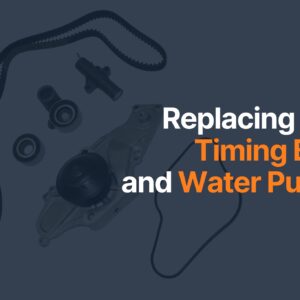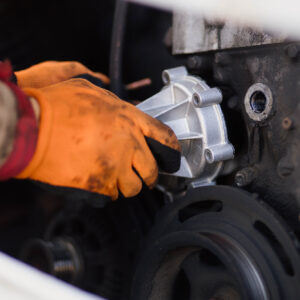You’ve probably heard that faulty parts need replacement as soon as possible. That rule applies to the water pump, the heart of the cooling system.
But how much does a water pump cost for a car? How much will the price tags of the replacement parts set you back? What about the labor cost? Knowing the costs will help you determine when to bring your vehicle in for repair–or even fix it yourself.
Water Pump Replacement Cost
Generally, replacing a bad water pump can cost you between $400 and more than $1,000. The water pump itself usually costs between $10 and $1,600.
Depending on the issue, you might also have to purchase other parts to replace damaged ones. These include water pump gaskets, water pump pulleys, water pump o-rings, and water pump seals.
Labor costs account for the balance of the water pump replacement cost. Mechanics will charge you for the work they put into fixing your vehicle.
Various factors affect the water pump replacement cost. Some makes and models command higher prices for replacement parts and related services because they’re more complex.
The location of the water pump can also contribute to the labor cost of replacing the part. Some water pumps are easily accessed, are driven by the serpentine belt, and can be changed in less than an hour. Other water pumps are driven by the timing belt and are more difficult, and still others are driven by the timing chain, making for a very expensive repair.
What Is a Water Pump?
Like the heart that pumps blood through the circulatory system, the water pump is the core of the liquid cooling system. It uses an impeller spinning very close to a matching reaction surface to move a mixture of antifreeze and water through the engine block and cylinder heads.
The coolant fluid absorbs heat from the engine, most particularly the heads, which are the hottest part of the engine, and carries heat to the radiator. After expelling the heat into the air, the coolant flows back to the engine, repeating the process.
Earlier vehicle models with water-cooled engines have mechanical water pumps driven by a drive belt that connects to the engine’s driveshaft. New models switched to electric water pumps that run on electricity from the electrical system. Some engines will have both electric and belt-driven water pumps.
Where Can You Find the Water Pump?
Depending on the vehicle’s engine design, the water pump might be in different locations. Most pumps are at the engine’s front, usually close to the timing belt and often driven by that belt.
Most vehicles have their water pump within the engine block. Instead of a separate drive belt, the engine’s timing belt drives the water pump.
On some vehicles, the water pump is in a separate housing. Several hoses attach the pump to the engine, carrying coolant to and from the pump.
In both arrangements, accessing the water pump requires removing the front cover or the drive belts.
Your vehicle’s service manual usually contains the location of the water pump and the recommended approach to replacing it. Alternatively, you can consult with the dealership that sold you the vehicle or mechanics whom you trust.
Bad Water Pump Symptoms
Most modern water pumps last at least 100,000 miles. However, they can fail or wear out prematurely. Water pumps have several moving parts and run for long periods, making them vulnerable to issues.
The following are the most common bad water pump symptoms:
- High reading in the water temperature gauge
- Coolant light turns on
- Check engine light turns on
- Smoke or steam from under your vehicle’s hood
- Low, grinding sound from the engine
- Leaked coolant on the ground under your vehicle
Reasons For Water Pump Failure
The following are possible reasons for the erratic operation or failure of the vehicle’s water pump:
- The damaged, loose, or missing impeller can’t push the coolant with sufficient force
- Cavitated reaction surface reduces pump efficiency
- Broken or loose drive belts
- Worn water pump bearings
- Bad water pump gaskets, hoses, seals, and tubes that cause coolant leak
- Erosion and fractures caused by cavitations
Can You Safely Drive with a Bad Water Pump?
No. Avoid driving your vehicle if its water pump isn’t working properly. A bad pump can’t send sufficient coolant flowing through the engine and cooling system to gather enough heat. The insufficiently cooled engine can run dangerously hot, damaging vulnerable parts like the seals that prevent coolant and oil leaks. In the worst-case scenario, the engine can fail, forcing you to spend an exorbitant amount to repair or replace it.
DIY Water Pump Replacement
You can change a water pump if you possess enough experience in DIY auto repair. The exact steps of the process might vary between vehicle models. If you have to remove the timing belt or the timing chain, you might want to hire the job done.
But if you wish to do it yourself, usually, you must drain the coolant and remove the drive belt before you can detach the bad water pump. After installing the replacement water pump, reattach the drive belt and fill the coolant reservoir with new fluid.
Consult the owner’s or service manuals for the specifics of the process to replace a bad water pump in your vehicle.
If you don’t have confidence in your ability to perform a DIY water pump replacement, let trusted mechanics replace the part for you.
Any information provided on this Website is for informational purposes only and is not intended to replace consultation with a professional mechanic. The accuracy and timeliness of the information may change from the time of publication.
































